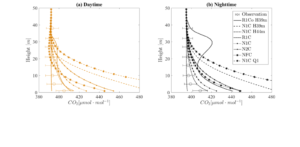
Journal of Advances in Modeling Earth Systems
, , , , & (2021). Modeling profiles of micrometeorological variables in a tropical premontane rainforest using multi‐layered CLM (CLM‐ml). Journal of Advances in Modeling Earth Systems, 13, e2020MS002259. https://doi.org/10.1029/2020MS002259
Abstract
This study updates the multi‐layered Community Land Model (CLM‐ml) for hillslopes and compares predictions from against observations collected in tropical montane rainforest, Costa Rica. Modifications are made in order to capture a wider array of vertical leaf area distributions, predict CO2 profiles, account for soil respiration, and adjust wind forcings for difficult topographic settings. Test results indicate that the modified multi‐layer CLM model can successfully replicate the shape of various micrometeorological profiles (humidity, CO2, temperature, and wind speed) under the canopy. In the single‐layer models (CLM4.5 and CLM5), excessive day‐to‐night differences in leaf temperature and leaf wetness were originally noted, but CLM‐ml significantly improved these issues, decreasing the amplitudes of diurnal cycles by 67% and 47%. Sub‐canopy considerations, such as canopy shapes and turbulent transfer parameters, also played a significant role in model performance. More importantly, unlike single layer models, the results that CLM‐ml produces can be compared to variables measured within the canopy to provide far more detailed diagnostic information. Further observations and model developments, aimed at reflecting surface heterogeneity, will be necessary to adequately capture the complexity and the features of the tropical montane rainforest.
Plain Language Summary
This study is to improve and examine a multi‐layered land‐surface model for a better understanding of the surface process and advanced future climate prediction. This study was made through comparison with a single‐layer model and with site observations about a tropical montane rainforest in Costa Rica. To apply the multi‐layer model at this site, we updated a vertical leaf distribution and turbulence scheme and added the CO2 profile and soil respiration scheme. The study showed the multi‐layer model could more correctly reflect the site uniqueness (e.g., extremely wet) and the complexity by hillslope, compared to the single‐layer model.
